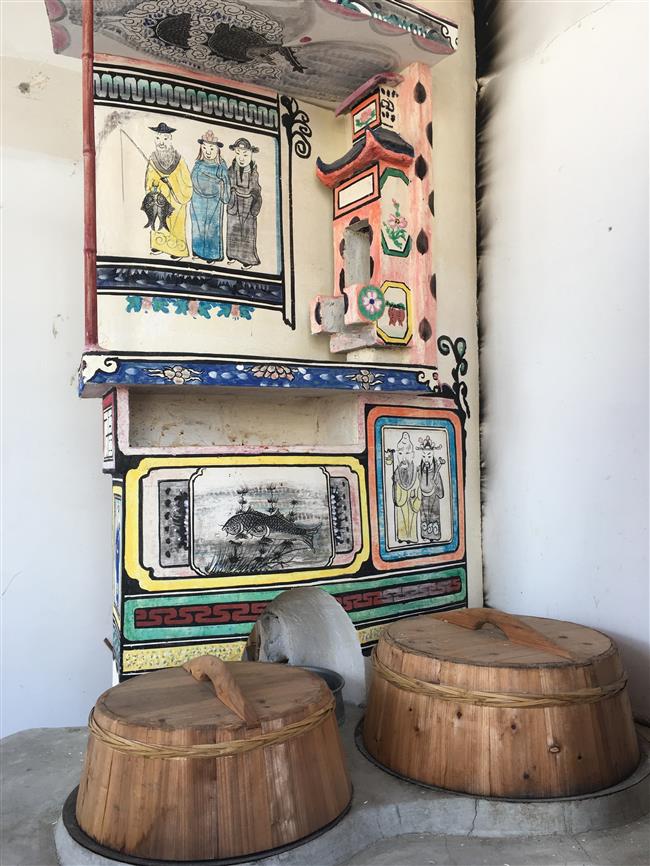Master craftsman of the stove paintings
At one time along the lower reaches of the Yangtze River, every farmhouse had a lime kitchen stove, or zaotou, that was painted with auspicious figures or floral motifs. Locals burned firewood and straw in it to cook, since there were no gas burners or microwave ovens.
Folk craftsmen expressed life’s passions through paintings on the stove. This special art was given national intangible cultural heritage status in 2011. In Jiaxing of Zhejiang Province, zaotou paintings typify this traditional art by virtue of their long history, skilled techniques and distinctive style.
Zhang Jinshou, 82, is considered the best plasterer in Jiaxing’s Xiuzhou District. He has been building stoves for more than 60 years and is famous for his bricklaying skills and ability to beautifully paint stoves from bottom to top.
A traditional zaotou consists of a base and a body that embraces embedded pans and a chimney pipe. The stove is around 2 meters in height and 1.5 meters wide.
It is made of bricks and clay and always set in a corner of the kitchen, leaving enough space between the back of the stove and wall so people can tend the fire.
“The diameter of the stove body varies according to pans. I need to measure the pan’s diameter before bricklaying,” Zhang told Shanghai Daily. “An ideal body size often helps save firewood and straw because of sufficient burning.
“During the heyday, I could have more than 10 orders in one day. I was the busiest person in village as almost every day I got a couple of orders to build a cooking stove.”
His work includes designing the painting’s layout since the stove is divided into several parts. The basic principle is that every blank space should be painted. The paintings on base, body and chimney pipe need to have the same general theme. Decorative borders, like waves or clouds, are used to frame the stove.
“Every plasterer taking charge of building a stove was also responsible for painting patterns, such as immortals, floral patterns, auspicious motifs, as well as scenery and calligraphy,” Zhang said.
No records have been found as to when this practice started, but according to local plasterers, paintings on stoves started at least two centuries ago and were invented by some plasterers who scribbled pot ashes on newly made white stoves.
That’s why the paintings were black and white at first. Later, people wanted more detailed pictures with vivid and contrasting colors.

Zhang Jinshou, considered the best plasterer in Jiaxing’s Xiuzhou District, paints on zaotou.
The Kitchen God and Longevity God are the most common immortals painted on zaotou, symbolizing wishes for a better life. Poetic willows and cowherd paintings and local fairy tales were also popular.
In Zhejiang Province, a stove was required in every household in the past. Fengshui always counts during construction. Usually, people invited a professional fengshui master to figure out the best time to build and the ideal location in the kitchen.
“The first and 15th days of every lunar month were often considered the best time. The awareness of fengshui was strong with locals at the time,” said Zhang.
On the chimney pipe there is a niche for a figurine of the Kitchen God, a Chinese god that protects the hearth and family. On the two auspicious days, locals often lit red candles to worship the god.
Zhang learned to be a zaotou maker when he was 16 thanks to his father’s skills of building such stoves. He soon became a famous zaotou master, whose work is scattered throughout villages in Jiaxing.
Zhang has made a living with his art for decades and has been recognized as an intangible heritage inheritor in Zhejiang. The government subsidizes him 5,000 yuan (US$720) every year to support this craftsmanship.
However, the grassroots art form is dying out. Modern stoves have replaced zaotou. Meanwhile, newly built farmhouses are no longer designed with space for this traditional culinary facility.
“This year, I have only built two zaotou. Some guesthouses need one to replicate old-style decor for tourists. The stove is used for ornamentation rather than cooking,” Zhang said.
Zhang’s father handed down the skill to him, and now he’s trying to pass it down to his son. The local government is also helping recruit an apprentice in a bid to preserve the craft. Nonetheless, he is worried about the future.
“In Xiuzhou District, only a few people can build and paint stoves,” Zhang said. “Young people are not interested in zaotou, because they think it is old-fashioned and won’t earn them money.”
However, Zhang clings to the traditional art and hopes someday descendants can appreciate such an interesting culture.

Zaotou paintings usually feature immortals, floral patterns, auspicious motifs, as well as scenery and calligraphy.
















